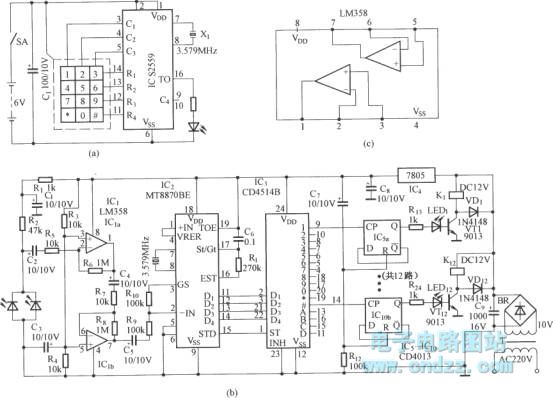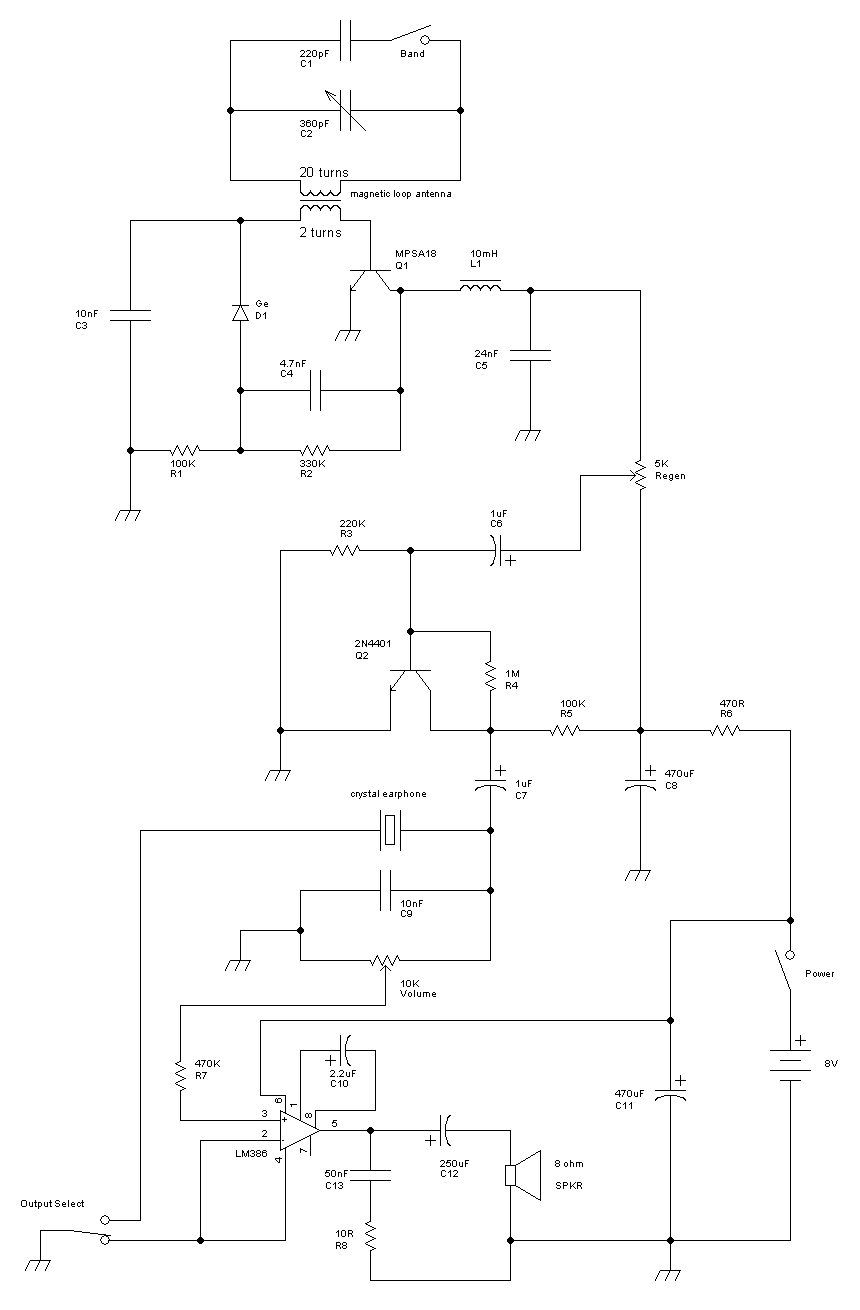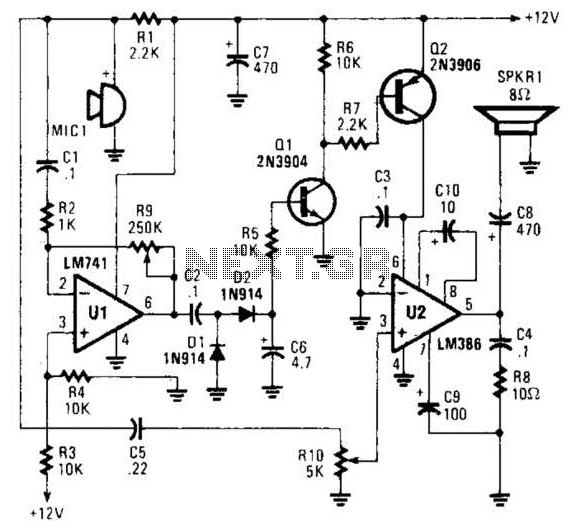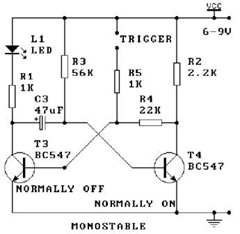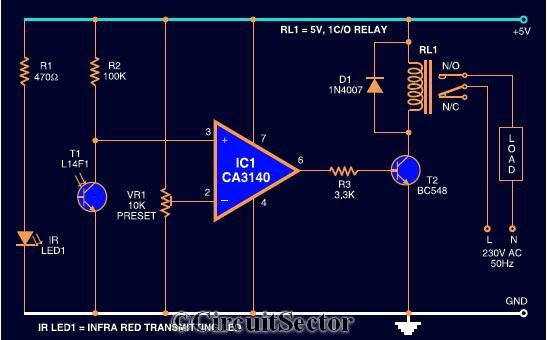
Universal multi-function alarm and timer circuit 555
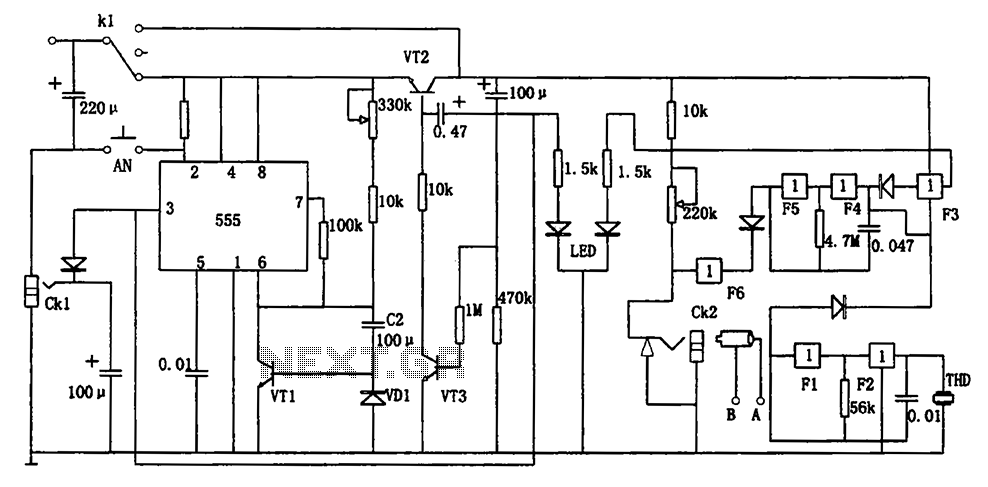
The circuit represents a general multi-function alarm and timing mechanism. Its timing capabilities range from 5 minutes to 3 hours. The timing components include C2, VD1, and VT1. The circuit utilizes a capacitance multiplier with a 555 timer. CK1, sourced from the timing input socket, operates at approximately 9V DC, facilitating timing for radio operations. K1 is configured for timing adjustments, activating the 555 timer output (6-9V) while VT2 remains off. Upon expiration of the timer, pin three of the 555 timer goes low, resulting in CK1 ceasing output voltage. This triggers VT2, activating the alarm circuit components F1 and F2, which generate both sound and light alarms for a duration of 20 seconds, while F3 to F5 are also engaged. Additional sensors for sound and light alarms can be integrated on both A and B sides of the circuit.
The described multi-function alarm and timing circuit is designed to provide versatile alarm functionalities through a combination of timing and sensor integration. The timing range of 5 minutes to 3 hours allows for flexibility in various applications, making it suitable for both short-term and long-term monitoring tasks. The use of a 555 timer, renowned for its reliability and ease of use, serves as the core timing mechanism.
The circuit configuration includes a capacitance multiplier, which enhances the effective capacitance seen by the timing circuit, thereby improving stability and response time. The input voltage of approximately 9V DC from CK1 is critical for the operational integrity of the circuit, particularly in radio applications where consistent timing is essential.
The activation of K1 allows for user-defined timing adjustments, enabling the circuit to cater to specific requirements. The 555 timer output, which ranges from 6V to 9V, indicates the readiness of the circuit to activate alarm functions. The transition of pin three from high to low upon timer expiration is a pivotal moment in the circuit operation, as it initiates the deactivation of CK1 and the subsequent activation of VT2.
The alarm circuit, comprising components F1 and F2, is designed to emit both sound and light signals for a specified duration of 20 seconds, ensuring that the alarm condition is effectively communicated. The additional outputs F3 to F5 provide further alarm functionalities, allowing for a comprehensive alert system. Furthermore, the capability to integrate various sensors on both sides of the circuit enhances its adaptability, enabling customization based on specific monitoring needs. This design exemplifies a robust solution for alarm and timing applications, combining ease of use with extensive functional capabilities. As shown for the general multi-function alarm and timing circuitry. The timing of the circuit can range from 5 minutes to 3 hours. Timing components C2, VD1 and VT1 composition capacitance multiplier circuit 555. CK1 from the timing input socket ~ 9V DC voltage, and so the timing for radio work. K1 is set to the timing gear, press the AN, 555 feet high output (6 ~ 9V), while VT2 off. When the timer expires, the three 555 pin goes low, CK1 no voltage output, VT2 is turned on, the alarm circuit F1 and F2 generation of the alarm sound and light alarm 20 seconds and F3 to F5 generated. A, B-side can add a variety of additional sensors sound and light alarm circuit.
The described multi-function alarm and timing circuit is designed to provide versatile alarm functionalities through a combination of timing and sensor integration. The timing range of 5 minutes to 3 hours allows for flexibility in various applications, making it suitable for both short-term and long-term monitoring tasks. The use of a 555 timer, renowned for its reliability and ease of use, serves as the core timing mechanism.
The circuit configuration includes a capacitance multiplier, which enhances the effective capacitance seen by the timing circuit, thereby improving stability and response time. The input voltage of approximately 9V DC from CK1 is critical for the operational integrity of the circuit, particularly in radio applications where consistent timing is essential.
The activation of K1 allows for user-defined timing adjustments, enabling the circuit to cater to specific requirements. The 555 timer output, which ranges from 6V to 9V, indicates the readiness of the circuit to activate alarm functions. The transition of pin three from high to low upon timer expiration is a pivotal moment in the circuit operation, as it initiates the deactivation of CK1 and the subsequent activation of VT2.
The alarm circuit, comprising components F1 and F2, is designed to emit both sound and light signals for a specified duration of 20 seconds, ensuring that the alarm condition is effectively communicated. The additional outputs F3 to F5 provide further alarm functionalities, allowing for a comprehensive alert system. Furthermore, the capability to integrate various sensors on both sides of the circuit enhances its adaptability, enabling customization based on specific monitoring needs. This design exemplifies a robust solution for alarm and timing applications, combining ease of use with extensive functional capabilities. As shown for the general multi-function alarm and timing circuitry. The timing of the circuit can range from 5 minutes to 3 hours. Timing components C2, VD1 and VT1 composition capacitance multiplier circuit 555. CK1 from the timing input socket ~ 9V DC voltage, and so the timing for radio work. K1 is set to the timing gear, press the AN, 555 feet high output (6 ~ 9V), while VT2 off. When the timer expires, the three 555 pin goes low, CK1 no voltage output, VT2 is turned on, the alarm circuit F1 and F2 generation of the alarm sound and light alarm 20 seconds and F3 to F5 generated. A, B-side can add a variety of additional sensors sound and light alarm circuit.
